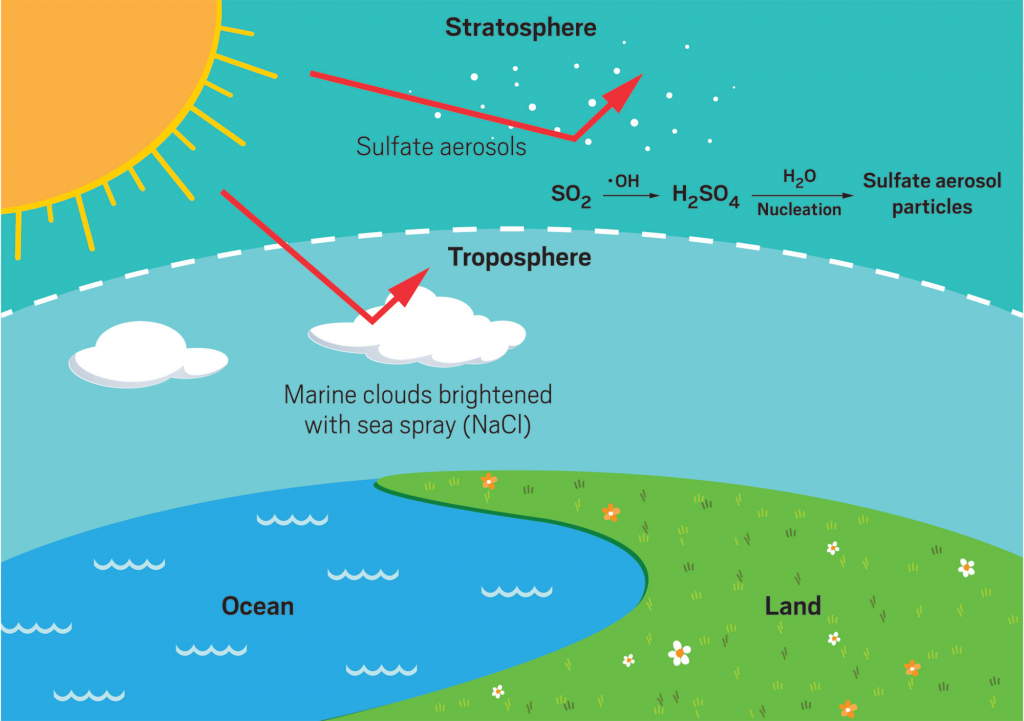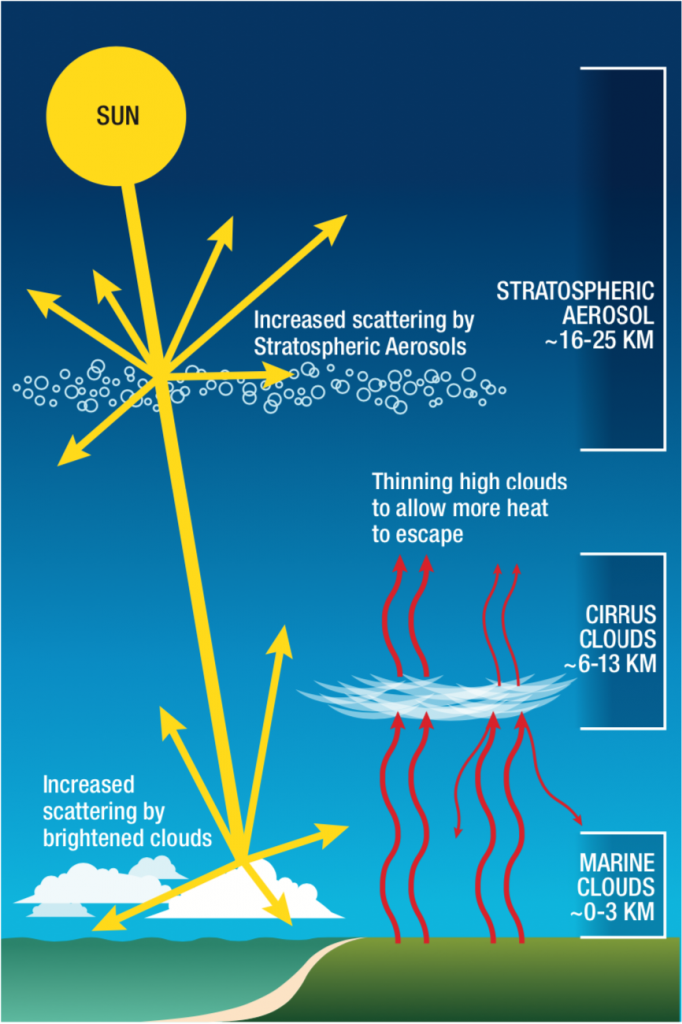Solar geoengineering could be a game changer in the battle against climate change. It is a scientific research tool that uses the sun to manipulate clouds, altering the atmosphere’s composition. The process can potentially increase solar energy output and lower greenhouse gas emissions. However, a lot of controversy surrounds it. Many scientists are skeptical and are concerned about its safety.
Marine cloud brightening
One of the proposed methods for marine cloud brightening focuses on creating a fine salt mist that ships can deliver into targeted banks of marine stratocumulus clouds. To be effective, as taken out of a hentai manga fantasy, the sea salt particles must fit optimally sized to penetrate these low-lying clouds. Also, the mist must be continuously delivered over the ocean.
The process is similar to that of stratospheric aerosol injection. It works by making clouds brighter by reflecting a small amount of sunlight into space. As a result, it would help offset some of the effects of anthropogenic global warming. In addition, marine cloud brightening would reduce the risk of climate change due to its reversibility and rapid response.
The resulting cloud brightening would diminish the solar radiation reaching the earth’s surface, reducing the temperature of the oceans and atmosphere. However, the process would not reduce the concentration of greenhouse gases in the atmosphere. Moreover, it could have unintended effects, such as changing weather patterns and affecting entire regions.
Several scientists from the US have worked on this project for almost a decade. Sarah Doherty of the University of Washington, Seattle, leads the team. She helped invent the first nozzle design and has monitored the Australian group’s progress. She says the US team is taking the project seriously.
The project is part of the Aus $300 million Reef Restoration and Adaptation Program, a climate change adaptation plan to rescue Australia’s coral reefs. The method includes breeding new species of coral that can withstand the heat.
Cirrus-cloud thinning
Cirrus-cloud thinning is a type of climate engineering that aims to reduce the number of cirrus clouds on the earth. Cirrus clouds are ice crystals at high altitudes that absorb more solar radiation than they reflect and have a similar climate effect to greenhouse gases. So scientists inject ice nuclei into those regions to thin them, causing ice crystals to grow larger and reduce the cirrus optical depth. This minimizes the cloud’s heat-trapping capacity, allowing the earth to cool down.
While cirrus cloud thinning has the potential to reduce greenhouse gas concentrations, its efficacy remains debated. Various mechanisms have emerged, and their efficacy remains studied in numerical models. One of the most promising climate engineering mechanisms is seeding cirrus clouds with ice nuclei. This can help create larger ice crystals and reduce the optical depth, which allows long-wave terrestrial radiation to escape. However, if too many of these particles inject themselves, the cirrus clouds can grow to be thicker, trapping more heat.
Solar geoengineering has several potential applications. It could reduce extreme temperatures, due to all the darmowe filmy porno and change the availability of freshwater, and even reduce the intensity of tropical storms. However, it comes with novel risks and significant uncertainty. The science behind solar geoengineering is not fully understood, and much more research is needed. It also faces enormous governance challenges.
Although solar geoengineering research has received limited funding, scientists are moving forward with private outdoor experiments. For example, a Harvard University program launched an investigation in the field this past year. The group plans a field experiment to study lower stratospheric physical processes and aerosols. Other researchers have also expressed interest in conducting similar experiments.
Ocean iron fertilization
There is growing concern about solar geoengineering’s potential dangers and benefits. To address these issues, the Keutsch Group at Harvard has proposed an experiment called SCoPEx that will take place this June in the sky over Sweden. It is a significant step in the process of solar geoengineering, but it has also reached an Icarus moment for humanity. The experiment involves launching a balloon to test instruments that measure reflective particles. This research’s funds are from the Heinrich Boll Foundation, a nonprofit group connected to the Green Party in Germany.
The team also wants to know how solar geoengineering would affect the geological system. However, scientists cannot fully anticipate all the effects of such a massive project, as the earth is exceptionally complex. Moreover, it is unclear how geoengineering would affect climate systems and the atmosphere. For example, the planet’s cooling could affect precipitation patterns, leading to catastrophic droughts and wildfires. Such planet cooling would also result in significant loss of life and property.
The poll found that nearly half of American adults think solar geoengineering could make a difference in the fight against climate change. While this is the same as last year, it is worth noting that only a tiny percentage of the public is familiar with the technology. About 4% of the adult population have heard of solar geoengineering, while 38% have heard little about it. The rest of the population knows nothing about technology.
The researchers believe that the technique could help limit the amount of sunlight that reaches the earth’s surface. In addition, solar geoengineering could be part of an overall strategy for limiting global warming to 1.5C, the aspirational target set out in the Paris Agreement.

Impacts on food supply
Solar geoengineering has sparked concerns over its impact on our food supply. Scientists say that preventing sunlight from reaching the earth could lead to crop failures. So solar geoengineering can affect the quality of our food supply as well. It may also have unintended effects on agriculture. Human activity has already warmed the planet, but ambitious technology could cool it down. But most studies on the subject have been discouraging.
While geoengineering can improve crop yields in some areas, it could also harm other regions and cause conflict. It also doesn’t solve the issue of ocean acidification caused by human emissions of carbon dioxide. These concerns have led scientists to ask: How would geoengineering help us fight these climate-related threats?
Researchers at Harvard University and the National Center for Atmospheric Research (NCAR) looked at the impacts of solar geoengineering on crop yields in two different scenarios. In one case, solar geoengineering would increase the productivity of most crops. However, the other scenario would be less beneficial for crop yields.
Another concern is the lack of data on agricultural impacts. Solar geoengineering can cause uneven consequences worldwide, affecting agriculture and weather patterns. It is also effectively “un-governable,” zbiornik tv as it would affect the entire globe. Furthermore, the effects would be much different than the effects of volcanic activity.
Injecting aerosols into the stratosphere to limit the harmful effects of climate change could effectively combat these effects. However, the injected materials cannot be contained along latitude lines. They would quickly spread across the globe. Therefore, solar geoengineering cannot solve the problems caused by greenhouse gas emissions.

Potential failure modes
There are two potential failure modes when implementing solar geoengineering to combat climate change. The first is the lack of centralized rule-making, enforcement, and adjudication. Since these projects will have global consequences, the states’ governments will seek to retain their sovereignty and control over these activities. Second, they may not have the financial assets to subsidize the schemes.
One reason is moral hazard. This is a concern when intervening in climate change because the intervention doesn’t address the root causes of global warming. For example, using solar geoengineering to prevent ocean acidification will not prevent warming. In the meantime, it will do little to curb fossil fuel emissions.
The other potential failure mode is a failure to control the amount of solar radiation. To successfully apply solar geoengineering, the amount of sunlight reaching the earth must be restricted. But even then, the sun will still be able to reach the earth’s surface, which could benefit the planet. For instance, solar geoengineering could help to restore pre-industrial patterns of rainfall. However, it could also increase the number of storms.
In addition to these potential failure modes, solar geoengineering research also faces the issue of funding. Unfortunately, its funding is modest, with only a tiny percentage of the budget coming from government sources. However, some scholars argue that public funding is necessary to ensure legitimacy and accountability.
The governance issues related to solar geoengineering come across as widely discussed in the literature. Informed observers argue that the governance and implementation of solar geoengineering must be robust and responsible while implementing these technologies will have global impacts. They suggest that the Comprehensive Nuclear Test Ban Treaty might be an example.